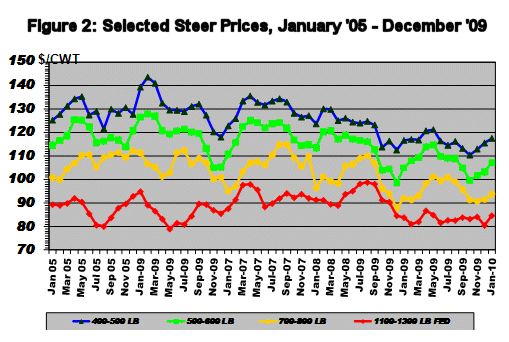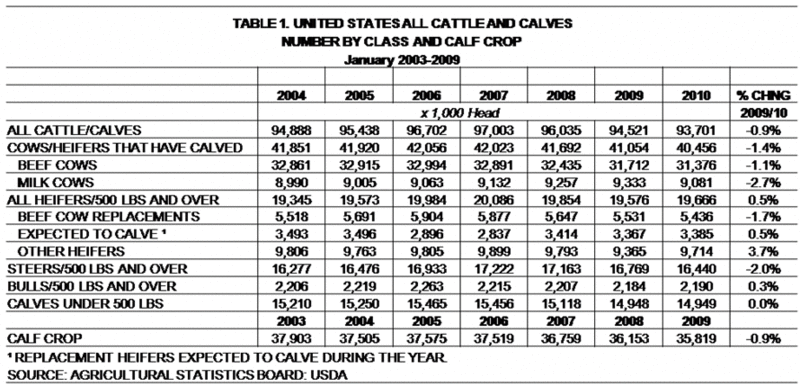Vol. 26, Issue 5, February 2, 2010 – PDF version
Jose G. Peña, Texas AgriLife Extension Economist-Management
According to USDA’s January 29, 2010 Cattle Report, the U.S. cattle inventory decreased for the third year in a row after three years of slight inventory increases. While excellent rainfall during the last five months has improved the forage production outlook, high input costs and weak markets continue to discourage herd re-building. The report was generally market neutral as the industry had anticipated a lower inventory. All cattle and calves in the U.S., as of January 1, 2010, totaled 93.7 million head, down 0.9 percent from an inventory of 94.5 million on January 1, 2009 and about 1.19 million head below the last cycle‘s low of 94.88 million head on January 1, 2004, when the herd re-building began. (See Figure 1). The size of the U.S. cattle herd is now the lowest since 1959.
 Beef Herd Down
Beef Herd Down
There was a decrease in the inventory in almost all categories, except in the inventory of over 500 pound beef replacement heifers expected to calve this year. A large portion of the inventory decrease was in the beef breeding herd. The inventory of beef cows and beef cow replacement heifers was down 1.1 percent, and 1.7 percent, respectively. It appears, however, that the rate of liquidation is slowing down. The inventory of over 500 pound (older heifers) beef cow replacement heifers, which are expected to calve this year, (older heifers) at 3.385 million head was up 0.5 percent from last year’s inventory of 3.367 million head.
The inventory of milk cows at 9.081 million head was down 2.7 percent from an inventory of 9.333 million head on January 1, 2009. The inventory of milk cow replacement heifers, however, at 4.516 million head was up 2.4 percent and the inventory of older milk cow replacement heifers over 500 pounds which are expected to calve this year was up and 1.1 percent from last year. (See Table 1).
The National Weather Service suggests improved rainfall conditions, at least through Spring 2010. Although moisture outlook may encourage some heifer retentions, the severe cold spell in the central part of the U.S. where over 60 percent of the cattle herd resides, high feed costs, high energy costs, a sluggish economy and downward pressure on the market will have a significant influence on whether liquidation of the U.S. beef cattle herd will continue.
Prices Up
After near record high prices for most beef cattle categories during spring ‘07 – September ‘08, prices weakened during much of 2009. Prices in Jan 2010 appear to be showing an upturn as the U.S. economy shows signs that a recovery may be underway , the rainfall situation improves and there is a potential for lower cattle supplies with a lower cattle inventory. (See Figure 2).
 Fuel, nitrogen and other energy related costs have come down from mid-summer 2008 highs, but total production costs remain high in relation to current market prices. Improved demand and stronger markets will be the key to herd re-building.
Fuel, nitrogen and other energy related costs have come down from mid-summer 2008 highs, but total production costs remain high in relation to current market prices. Improved demand and stronger markets will be the key to herd re-building.
Calf Crop Down
The 2009 calf crop was estimated at 35.819 million head, down 0.9 percent from an 36.153 million calves born in 2008. Calves born during the first half of the year (spring 2009 feeder calf crop) were estimated at 26.0 million, down 1.15 percent from 26.3 million head born during the same time in 2008.
Feedlots Below Capacity
Meanwhile, feedlots appear to be operating significantly below capacity. According to USDA’s January 22, 2010 Cattle-on-Feed report, cattle and calves on feed for the slaughter market in the U.S. in feedlots with capacity of 1,000 or more head totaled 11.0 million head on January 1, 2010, down 1.8 percent from January 1, 2009 and down 7.2 percent from January 1, 2008.
Cattle placements in feedlots during December ‘09, totaled 1.55 million, down 6.1 percent from December ‘08 and 9.1 percent below December ‘07.
Ample Meat Supplies
Meanwhile ample supplies of total red meat and poultry will be produced in 2010. While total beef and pork production in 2010 is projected to drop 1.8 percent and 1.6 percent, respectively, poultry production is expected to increase by about 0.9 percent. Total red meat and poultry production for 2010 at about 90.5 billion pounds will be down just slightly from about 90.9 billion pounds produced in 2009.
Improved Livestock Production Level
While the Jan 1, 2010 all-cattle inventory is the lowest since 1959, production level has increased significantly in livestock production systems. For example, in 1977 about 24.8 billion pounds of beef and veal were produced with a Jan 1, 1977 cattle inventory of 122.1 million head. This year, about 25.5 billion pounds of beef will be produced from an all-cattle inventory of 93.7 million head, 29.1 million head lower than in1977. In addition, in 1977 about 6.425 billion bushels of corn were harvested from about 70.872 million acres with an average U.S. yield of 90.7 bushels/acre. According to USDA’s Jan 12, 2010 Supply-Demand report, a record high 13.151 billion bushels of corn were harvested this season from 79.6 million acres of corn with a U.S. average yield of 165.2 bushels/acre.
Appreciation is expressed to Stan Bevers for his contribution and to review this article.

